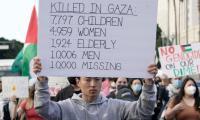Over 40 Indian soldiers of the paramilitary Central Reserve Police Force (CRPF) were killed on February 14 in Pulwama, Occupied Kashmir in a car bombing that shook India, the wider region, and global affairs for India and Pakistan, to their core.
The initial casualties of the Pulwama attack were Indian soldiers. This is part and parcel of the dynamic between a brutal occupying force of a hegemonic and unhinged regional power, namely India, and the brave and fearless Kashmiri people, who have suffered a 70-year occupation with unmatched dignity and integrity.
Pakistan’s official reaction to the Pulwama attack has been very measured and should be welcomed. Prime Minister Imran Khan repeated his core mission in the region, one that he has repeated several times, of seeking détente and peace with India. He also warned India of retaliation if Pakistan was provoked. The official armed forces spokesperson also gave an impassioned presentation about option 1 and option 1A for Pakistan: which is peace, and more peace. But he also elaborated on Pakistan’s quest for peace, whilst being prepared for war. Pakistani diplomats, and especially Pakistan’s two brilliant daughters – Dr Maleeha Lodhi at the UN in New York and Tehmina Janjua at the Ministry of Foreign Affairs in Islamabad – engaged Pakistan’s bilateral partners and friends and explained the position of the pro-peace government of Pakistan.
Despite all these measures, while India counts its dead, it is also important to take stock of the damage that the Pulwama attack has inflicted on the Pakistani side. The aftermath of the Pulwama attack exposes three realities about Pakistan that need to be accounted for in the short, medium and long term thinking of the military leadership through the army’s Corps Commanders Conference, the intelligence community through rank and file officers of the ISI, and to a lesser extent, the inner circle of Prime Minister Imran Khan, and BPS 20 and below officers of the foreign service. What are these three realities?
The first reality is the damage that has been done to the Kashmir cause. India has successfully cobranded the Kashmiri struggle for self determination with the UNSC Resolution 1267 listed Lashkar-e-Taiba (LeT) and Jaish-e-Mohammad (JeM) (and their derivatives such as Jamaat ud Dawa (JuD), and Falah e Insaniyat Foundation (FIF)). Unlike three decades ago, Kashmir today does not enjoy any significant salience in the wider Muslim world outside of Pakistan.
The second reality that Pulwama reminds us of is the vulnerability of Pakistan to a punitive international system. In the voice and visibility of proscribed and listed organisations like LeT and JeM, members of the international community have an easy and readily available instrument with which they can curry favour with India, or equally, with which they can punish Pakistan for grievances they may hold against this country. This vulnerability is especially pronounced because Pakistan – which has just completed its latest round of funding its fiscal deficit through foreign funding – does not enjoy fiscal sovereignty. Sanctions regimes, the Financial Action Task Force and even IMF negotiations are all much more menacing and toxic for Pakistan, because of our failure at managing and muting banned organisations like the LeT and JeM.
The third reality that Pulwama has exposed is that the spectre of non-state actors (notwithstanding whether the world’s accusations are true or not) has fundamentally altered the strategic space that Pakistan operates in, and has damaged the concept of Pakistani territorial sovereignty. Non-state actors that are deemed malignant by the international community are part and parcel of the burden that Pakistani diplomats must bear in every international forum. Adversarial actors such as India, and at times the US, have successfully used accusations of Pakistani safe havens for these kinds of groups to cross Pakistan’s red lines, with little reaction from us. These accusations are rooted in the freedom that members of these groups enjoy to make speeches, and in one case, to build political parties and participate in elections.
In 2011, the US breached these red lines twice. Once in May 2011 in pursuit of Osama Bin Laden in Abbottabad, and then again at the border with Afghanistan at the Salala post, in a brazen attack on Pakistani soldiers that has, to this day been neither investigated properly by Pakistan nor accounted for adequately by the US. In neither case we were able to mount a credible response.
In 2016, after the Uri attack in Occupied Kashmir, India claimed to have conducted ‘surgical strikes’ inside Pakistani territory. And yesterday, after Pulwama, India once again breached these red lines, and flew Mirage 2000 fighter jets into Pakistani territory, dropping payload in the skies above Balakot.
Once adversaries identify their targets as being capable of taking a hit without retaliating, the outer perimeter of acceptable provocative behavior changes. The space to operate and response to future attacks shrinks. Pakistan has established precedence of being able to absorb the attacks of friends (like the US) and enemies (like India). Future breaches of Pakistan’s red line therefore have less fear of retaliation associated with them. This was the view of experts in the immediate aftermath of the OBL raid by the US. In the skies above Muzaffarabad and Balakot, with ordinary Pakistanis bravely looking up to stare down India’s military hardware, that view came to fruition.
The solution to these three realities is not a military retaliation to India’s brazen act of aggression and provocation. India is a nation of unparalleled potential, but its size and economic clout has instigated rogue, hegemonic behaviour, made worse by religious extremists having successfully brainwashed hundreds of millions of their countrymen into an existential right-wing frenzy – perhaps because the Indian elite knows that it cannot live up to the fiction of India as a true global power that serves its poorest and most vulnerable people. Prime Minister Narendra Modi, already on the ropes in what promised to be a close election, needed an intervention. The Pulwama attack provided the opening. Any escalation of military action between Pakistan and India will only serve to whet the appetite of PM Modi’s war-mongering inner circle.
Perhaps more importantly, Pakistan is in the midst of trying to avoid devastating further reductions in public expenditure – mainly by borrowing money from countries like Saudi Arabia, the UAE and China – none of whom is interested in either Kashmir or Pakistani masculinity – and all of whom are invested in Pakistan’s economic potential. Can such a Pakistan afford any war at all, no matter how limited? Absolutely not.
The truth is that Pakistan’s incredible soldiers, spies and policemen and women have already fought India and won. The war on the TTP and associated foreign funded terrorist groups is essentially over. Pakistan and its security establishment should be reaping the rewards of this victory (through economic growth and peacetime), not readying to deploy to forward positions once again.
Among the P5+1 countries, Germany, France, the US, the UK and Russia, may all support India when it comes to choosing between India’s narrative and the LeT, JeM or HQN. So too will China. No country on the planet will choose UNSC 1267 listed organisations over the world’s largest democracy – no matter how rotten and poisonous the fruit of that democracy may be.
The people of Kashmir are much braver and more inventive than any of the blanks that these organisations have been firing since 1998. The Kargil fiasco marked the end of the old world. Anyone that truly cares about the future of Kashmir, the legitimacy of its struggle, anyone that truly cares about Pakistani sovereignty, anyone that truly cares about Pakistani soldiers, their sacrifices, can only come to one conclusion. It is time to take away India’s alibis in Pakistan. It is time to end the visibility of banned organisations.
The writer is an analyst and commentator.
Earth Day protests carry a vital message that is relevant 365 days a year. — AFP File Earth Day is celebrated every...
People walk along a market in Lahore on May 17, 2023. — AFP/FileMany of us had hoped that the general election...
Packs of freshly printed $20 notes are processed for bundling and packaging at the US Treasury's Bureau of Engraving...
People stand in line up as election officials check their ballot papers during voting general election at a polling...
Women show their voter identity cards as they stand in a queue before casting their votes in Agartala. — PTIThe 18th...
Former prime minister Imran Khan. — Instagram/ imrankhan.ptiAn old saying has it that “when you dance with the...







